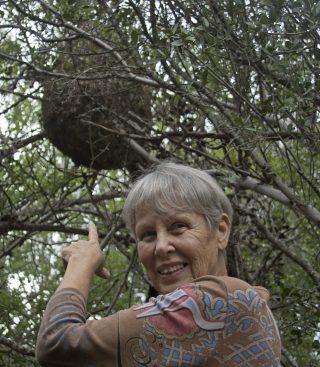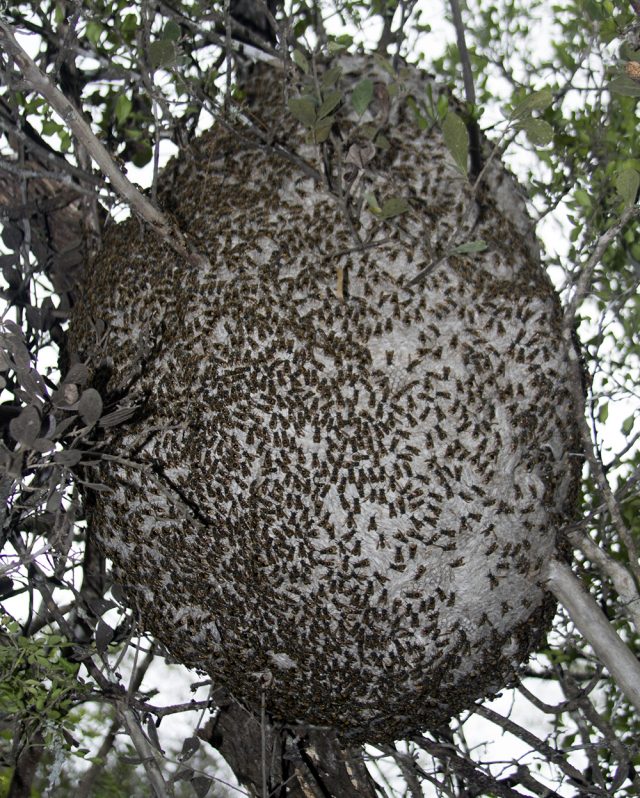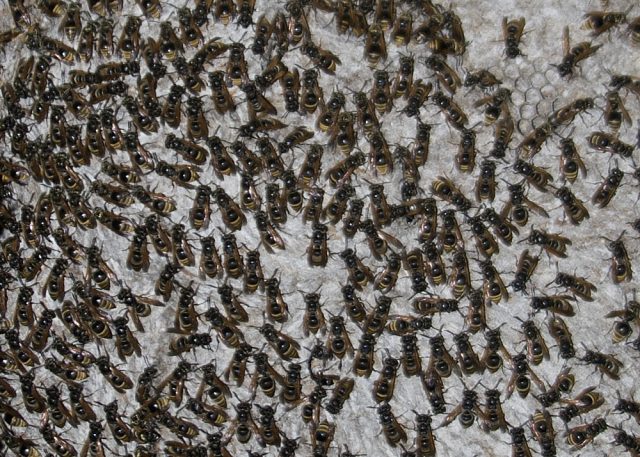
Nancy Lawson of Cadiz found this mature Mexican Honey Wasp nest along walking trails on her property. It is possible to get quite close to the nest as the wasps are non-aggressive unless provoked. If you jostle the limbs supporting the nest, the wasps will warn you with a soft hissing like the sound of pouring fizzy Coke over ice. Robert Benson Photo
11 Nov 2016 – Mexican Honey Wasps
It looked like a hornets’ nest in an old Loony Toons cartoon: Big and gray and papery…and crawling with bees! What was this thing?
My friend Nancy decided to keep a safe distance away while she photographed it with her phone. Thank goodness for that “zoom in” feature on iPhones! She didn’t want to take any chances of getting stung by hornets.
As soon as we saw the photos, we knew it was not a hornets’ nest. And those were not small honeybees going in and out of a hole on the side. They were wasps: Mexican Honey Wasps.
I talked my husband in to coming with me to photograph Nancy’s Mexican Honey Wasps. I had read that these wasps are rather mild-mannered as far as vespid wasps go. In general, you can get quite close to a nest if you do not harm it, the website said. (Somehow, I interpreted this comment as “they would not sting.”)
We got up close. I jostled a limb slightly. The wasps let out soft hissing sound reminiscent of a soda being opened. I pulled a persimmon limb aside to get a better look. Again the hiss. They had warned me, and they had had enough. One of the wasps zapped me on the neck. It stung, of course, but I laughed it off. After all, I am a Texas Master Naturalist…and a big girl. But the wasp’s sting kept on stinging, and hurting for hours. The initial zap of pain revisited me every few minutes in waves.

You can see that the papery nest is large, almost two feet high, and likely contains several pounds of very palatable honey. These social insects are one of the few species besides bees that produce honey. Robert Benson Photo.
I don’t know who came up with the idea to try to get a bit of the wasps’ honey for a taste. But yes, that is what we did. Robert poked the nest with a sharp stick. After we ran out of range (we thought) we tasted the tip of the stick. A distinct strongly-scented honey was evident. But those wasps didn’t want to share. One stung my husband on his head, and another one got me. It was time to leave.

With their striped abdomens, Mexican Honey Wasps resemble tiny bees. They are superior pollinators of native flowers, avocados, and citrus. They also prey on insects that damage citrus crops! Robert Benson Photo.
With my new-found respect for Mexican Honey Wasps, I decided to find out more about these insects. There is a lot of information on the wasps’ value as pollinators, pest controllers, and honey producers. There was very little about their stinging ability, except for a note that some Brazilian tribes used them as a rite of passage into manhood. (It figures.)
Mexican Honey Wasps (Brachygastra mellifica) are found in North and South America, but they have only moved into south Texas during the last 50 years or so. Like honeybees, they are social insects, living together in a colony. Mexican Honey Wasps are one of the few insect species besides bees to produce honey.
Early on, this honey-producing ability caught the attention of humans occupying the same area. Mexican Honey Wasp nests contain large stores of palatable honey. Native peoples harvest the honey by cutting off the bottom of the nest leaving the base still attached to the tree. The wasps rebuild the nest, allowing for exploitation again next year. Some farmers become “vespiculturists” by taking the whole nests when small and relocating them to their gardens. Periodically, the wasp farmers oust the insects with smoke, chop open the nest to get the honey, and allow the wasps to return and rebuild the colony.
Charles Hogue in his Latin American Insects and Entomology (1993) describes the nest building process. The wasps build semi-concentric rings of combs that they suspend from a branch. They make the combs of “a relatively fragile paperlike material which they produce by chewing wood fibers and mixing them with salivary secretions.” The outer surface of the nest is a baglike envelope of a much stronger version of “wasp paper.” There is usually only a single entrance to the nest near the bottom of the bag. Newly founded nests reach “smallish football-size in about 30 to 40 days.” Mature nests can be up to three feet long and can contain as much as five pounds of honey.
Foraging workers visit flowers to gather nectar. Pollen sticks to their hairy bodies as well. At the nest, other worker wasps transport these provisions to the interior. Much of it is stored as winter food. Developing larvae are fed an exclusive diet of honey and pollen, which is unusual among wasp species.
Mexican Honey Wasps, like most wasps, are predators at least part of the time. Although they gather nectar and pollen from flowers, these wasps also prey on a variety of insect pests. The psyllid Diaphorina citra is a very destructive pest in citrus groves. D. citra makes the fruit inedible and slowly destroys the citrus trees. This insect is common, especially in the late summer. Mexican Honey Wasps feast on these psyllids and decimate their populations. This behavior makes the wasps a very effective biological control agent for citrus farmers.
Perhaps the most valuable contribution of the Mexican Honey Wasp is as a pollinator. Not only do they pollinate a number of native plants, they are extremely beneficial in avocado and citrus orchards. Before the introduction of the honeybee to the Americas, stingless bees and wasps were the chief pollinators for the avocado tree. Mexican Honey Wasps are better at pollination than most wasps because they have a great many pollen-catching hairs on their heads and unique thoracic cavities to hold pollen.
A mature colony of Mexican Honey Wasps can have anywhere from 3,000 to 20,000 individuals. A nest is perennial and usually lasts about three years before the colony moves on. During that time, the numerous queens produce thousands of worker wasps. These wasps are valuable pollinators, predators on pest species, and as honey-producers. However, I strongly urge you NOT to provoke them!
If you would like to offer comments, please click through to the discussion page
